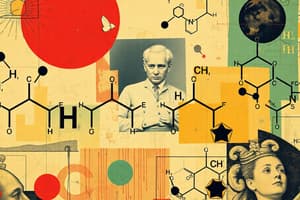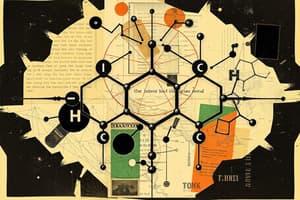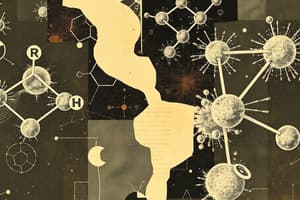Podcast
Questions and Answers
What defines a compound in chemistry?
What defines a compound in chemistry?
- A solid material that cannot be broken down by chemical reactions.
- A substance formed from two or more elements connected by chemical bonds. (correct)
- A type of element that only contains carbon.
- A substance that consists of a single type of atom.
Which statement accurately describes organic compounds?
Which statement accurately describes organic compounds?
- They include carbonates and cyanides.
- They can only be derived from petroleum sources.
- They are primarily made from carbon and hydrogen. (correct)
- They always contain a C-C bond.
Which of the following is NOT considered an inorganic compound?
Which of the following is NOT considered an inorganic compound?
- Methane (CH4) (correct)
- Silicon carbide (SiC)
- Calcium carbonate (CaCO3)
- Sodium cyanide (NaCN)
What is the primary source of organic compounds?
What is the primary source of organic compounds?
Which bonding type involves the sharing of electrons between atoms?
Which bonding type involves the sharing of electrons between atoms?
Which of the following statements about inorganic compounds is true?
Which of the following statements about inorganic compounds is true?
What characterizes a covalent bond?
What characterizes a covalent bond?
Which of the following best describes the electronegativity role in carbon's bonding?
Which of the following best describes the electronegativity role in carbon's bonding?
What characteristic of metallic bonding contributes to high electrical and thermal conductivity?
What characteristic of metallic bonding contributes to high electrical and thermal conductivity?
Which of the following statements about organic compounds is true?
Which of the following statements about organic compounds is true?
Which property differentiates inorganic compounds from organic compounds?
Which property differentiates inorganic compounds from organic compounds?
What is the melting point behavior of table salt when heated?
What is the melting point behavior of table salt when heated?
Which statement regarding the solubility of organic and inorganic compounds is correct?
Which statement regarding the solubility of organic and inorganic compounds is correct?
Which type of bond do most organic compounds primarily form?
Which type of bond do most organic compounds primarily form?
What can be inferred about the combustibility of inorganic compounds?
What can be inferred about the combustibility of inorganic compounds?
Which compounds are characterized by high melting and boiling points?
Which compounds are characterized by high melting and boiling points?
Which property is generally associated with organic compounds?
Which property is generally associated with organic compounds?
Who was the first to define organic chemistry as a branch of modern science?
Who was the first to define organic chemistry as a branch of modern science?
What key concept did Jon Jacob Berzelius believe in regarding organic compounds?
What key concept did Jon Jacob Berzelius believe in regarding organic compounds?
Which process involves the breakdown of complex organic compounds by microorganisms?
Which process involves the breakdown of complex organic compounds by microorganisms?
What was notably synthesized by Valerius Cordus in 1540?
What was notably synthesized by Valerius Cordus in 1540?
Which scientists first isolated the first known amino acid in 1806?
Which scientists first isolated the first known amino acid in 1806?
What was discovered by Emil Fischer and Hofmeister about proteins in the 1900s?
What was discovered by Emil Fischer and Hofmeister about proteins in the 1900s?
Which process is used by oil refineries to separate crude oil into fractions based on boiling points?
Which process is used by oil refineries to separate crude oil into fractions based on boiling points?
What is the primary role of cholesterol in the human body?
What is the primary role of cholesterol in the human body?
Which compound did Friedrich Wöhler first synthesize from ammonium cyanate?
Which compound did Friedrich Wöhler first synthesize from ammonium cyanate?
What does catenation refer to in the context of carbon chemistry?
What does catenation refer to in the context of carbon chemistry?
Which of the following formulas best represents the simplest whole number ratio of the atoms in butene?
Which of the following formulas best represents the simplest whole number ratio of the atoms in butene?
What is the main characteristic of a molecular formula?
What is the main characteristic of a molecular formula?
What significant discovery is attributed to August Kekulé?
What significant discovery is attributed to August Kekulé?
Which one of the following statements about electronegativity is true?
Which one of the following statements about electronegativity is true?
What does the condensed structural formula do?
What does the condensed structural formula do?
What differentiates an alkene from an alkane?
What differentiates an alkene from an alkane?
Which type of compound contains a benzene ring structure?
Which type of compound contains a benzene ring structure?
What does a skeletal formula represent?
What does a skeletal formula represent?
What happens to an alkane when one of its hydrogen atoms is replaced by a functional group?
What happens to an alkane when one of its hydrogen atoms is replaced by a functional group?
What is the defining characteristic of saturated compounds?
What is the defining characteristic of saturated compounds?
What type of bond is present in alkynes?
What type of bond is present in alkynes?
What is the role of IUPAC nomenclature?
What is the role of IUPAC nomenclature?
Which of the following is a characteristic of unsaturated compounds?
Which of the following is a characteristic of unsaturated compounds?
Flashcards are hidden until you start studying
Study Notes
Compounds
- Compounds consist of more than one type of atom connected by chemical bonds.
- Chemical reactions can simplify compounds into their constituent elements.
Organic Compounds
- Comprised mainly of carbon and hydrogen, often in covalent bonds.
- Carbon has four valence electrons, enabling it to bond with itself, hydrogen, and other electronegative elements like oxygen, nitrogen, and halogens (e.g., fluorine, chlorine).
- Derived from plants, animals, petroleum, coal, and natural gas; can also be synthesized in labs for products like fertilizers and medicines.
Inorganic Compounds
- Formed from two or more elements, typically containing a metal and a nonmetal, without C-C or C-H bonds.
- Sources include minerals, metals, rocks (e.g., marble and granite), and gemstones.
Chemical Bonds
- Chemical Bond: A lasting attraction between atoms in molecules or ions in crystals.
- Ionic Bond: One atom donates an electron to another, leading to electron sharing.
- Covalent Bond: Electrons are shared equally between atoms.
- Metallic Bond: Electrons are pooled in an "electron sea," allowing conductivity.
Properties of Compounds
- Composition: Organic contains carbon and hydrogen; inorganic has no C-C or C-H bonds.
- Bonding: Organic compounds primarily have covalent bonds; inorganic compounds may exhibit ionic and covalent bonds.
- Structural Units: Organic compounds form molecules; inorganic compounds form ions.
- Forces of Attraction: Organic compounds experience intermolecular forces; inorganic compounds experience interionic forces.
- Electrical Conductivity: Organic compounds do not conduct electricity as they do not form ions; inorganic compounds can conduct electricity when molten or in solution.
- Melting and Boiling Points: Organic compounds generally have low melting/boiling points; inorganic compounds usually have high melting/boiling points.
- Solubility: Organic compounds are non-polar and insoluble in polar solvents like water, but soluble in organic solvents; inorganic compounds are ionic/polar and soluble in polar solvents.
- Combustibility: Organic compounds burn in air; inorganic compounds do not.
- Volatility: Organic compounds are more volatile compared to inorganic compounds.
Organic Chemistry
- The study of carbon-containing compounds, defined in the early 1800s by Jon Jacob Berzelius.
- Berzelius classified compounds as organic (from living matter) or inorganic (from mineral origins) and believed in vitalism—the notion that organic compounds arise only from living organisms.
Historical Discoveries
- 8000 BC: Ethanol production via fermentation; breakdown of organic compounds by microorganisms.
- 340 BC: Aristotle proposed vitalism.
- 1250: Taddeo Alderotti developed fractional distillation.
- 1540: Valerius Cordus synthesized diethyl ether, an early anesthetic.
- 1806: Vauquelin & Robiquet isolated the first known amino acid—a component crucial for bodily functions.
- 1900s: Work by Emil Fischer and Hofmeister clarified proteins as amino acid polymers.
- 1828: Friedrich Wöhler synthesized urea from ammonium cyanate.
- 1856: William Henry Perkin unintentionally synthesized mauveine while aiming for quinine.
- 1865: August Kekulé drew first organic compound structures using bonds.
Chemical Properties
- Ionization Energy: Energy needed to remove an electron; carbon exhibits high ionization energy and electronegativity.
- Catenation: Carbon's ability to form long chains of atoms.
Organic Formulas
- Molecular Formula: Displays actual atom count in a molecule (e.g., C₂H₄O₂).
- Empirical Formula: Simplest ratio of atoms (e.g., Butene as CH₂).
- Structural Formula: Shows atoms and bonds.
- Condensed Structural Formula: Lists atoms sequentially in a single line.
- Skeletal Formula: Omits hydrogen; lines represent carbon atoms.
Hydrocarbons
- Types:
- Alkane: Single bonds between carbons.
- Alkene: Contains a double bond.
- Alkyne: Contains a triple bond.
- Functional Groups: Include alcohols (OH), ethers (OR), aldehydes (CHO), ketones (CO), and carboxylic acids (COOH).
- Aliphatic vs. Aromatic: Aliphatic compounds can be straight/branched; aromatic compounds contain a benzene ring.
IUPAC Nomenclature
- Systematic naming based on carbon atom count; alkanes named with a corresponding prefix and the suffix -ane.
- Alkanes dominate crude oil compositions.
Studying That Suits You
Use AI to generate personalized quizzes and flashcards to suit your learning preferences.




